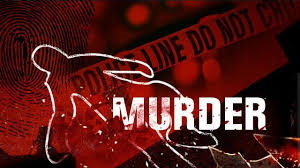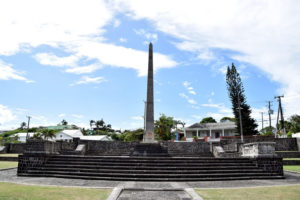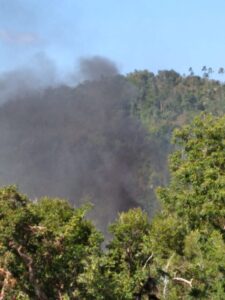Published 18 January 2018
Buckie Got It, St. Kitts and Nevis News Source
Jamaica professor links narcotics and illegal trade in guns to high murder rate in the region
Basseterre, St. Kitts, January 18, 2018 – Of the 25 most murderous countries in the world, St. Kitts and Nevis and Jamaica are among the Caribbean group which leads with nine states, followed by Latin America and Africa with eight each.
“The Caribbean ignominious list includes Jamaica, Belize, St Kitts and Nevis, The Bahamas, Trinidad and Tobago, St Vincent and the Grenadines, Dominican Republic, St Lucia, and Dominica. The Latin American list includes Honduras, Venezuela, El Salvador, Guatemala, Colombia, Brazil, Mexico, and Panama,” said Professor Dr. Paul Golding, Dean of the College of Business and Management, University of Technology in Jamaica.
In a column in the Jamaica Observer, Dr. Golding said Jamaica, the Caribbean and Latin America are experiencing a crisis in murders.
Murders in Jamaica for 2017 were the second-highest in recorded history — surpassed only by 2009 when 1683 were recorded.
In the article headlined: “The wedded bliss between illegal guns trade and high murder rate,” Professor Golding noted that based on available data from the United Nations Office on Drugs and Crime (UNODC) the region has the highest rates of homicide/murders in the world.
“If we were to follow the logic behind the Jamaican crime plan, Jamaica’s Prime Minister Andrew Holness should encourage his other regional leaders to declare the region a zone of special operations. Truth be told, any international assessment of murders by country in the world would designate Jamaica and the other countries mentioned above as garrisons.
Since the late 1970s the nature and volume of murders in Jamaica has changed. In 1962 there were 63 reported murders, 188 in 1972, and 889 during the 1980 bloody general election. Prior to the 1980 election, the majority of homicides were with blunt instruments and sharp weapons like ratchet knives and machetes. Tribal politics and, more importantly, the increase in transnational narcotics trafficking has plunged the region into its current crisis.”
“The UNODC, in a 2012 threat assessment report, indicated that the paramount crime issue in the region is cocaine trafficking, the groups empowered by it, and the violence associated with this flow. A 2007 World Bank report on ‘Crime, Violence, and Development in the Caribbean and Latin America’ highlighted that the drug trade drives crime in a number of ways: through violence tied to trafficking, by normalising illegal behaviour, by diverting criminal justice resources from other activities, by provoking property crime related to addiction, by corrupting societal institutions, and by contributing to the widespread availability of firearms. The widespread availability of powerful small arms has resulted in higher mortality levels as they have been used to settle lotto scamming disputes, instil fear, command respect, demand sexual favours, and has spawned other industries like guns for hire,” said Dr. Golding.
He continued: “There is generally an inverse relationship between the production of small arms and the incidence of homicides. The 2014 Small Arms Survey indicates that the top exporters of small arms, in descending order, were the United States, Italy, Germany, Brazil, Austria, Switzerland, Israel, the Russian Federation, South Korea, Belgium, China, Turkey, Spain, and the Czech Republic. Except for Brazil, all these small arms manufacturers have very low murder rates. Homicide rates in these countries, per one hundred thousand, are generally in the single digits — in a number of cases below one: Spain and the Czech Republic (0.7), China and Italy (0.8), USA (3.9). In contrast, the countries with the top homicides rates range from Honduras with 90.4 per one hundred thousand to Panama with 19.2.
For any industry to survive it needs to grow and the market for small arms is a growth industry. Between 2001 and 2011 the values of global trade in small arms and light weapons have almost doubled according to the UN Commodity Trade Statistics. The category of small ammunition had the greatest increase of over 205 per cent. The most recent estimates indicate that the market is expected to grow from an estimated US$4.09 billion in 2015 to US$4.92 billion by 2020, at a compound annual growth rate of 3.8 per cent from 2015 to 2020,” Dr. Golding said.
He is of the view that the market for small arms is driven by several factors, including the rising number of wars and cross-border disputes, the rise in terrorism and the increasing civilian use of small arms for sports and self-defence. Regionally, a major factor that drives the use of small arms is the narcotics trade.
“The recent seizure of over 100 illegal small arms destined for Jamaica by the US Customs and Border Protection and Outbound Enforcement Team at Miami International Airport in Florida gives a vivid snapshot of what helps to drive homicides in Jamaica and the region. The USA is a major supplier of illicit small arms to the Caribbean and Latin America, with more than 50 per cent of all unlawfully acquired firearms being of US origin.
It is important to understand the link between the legal and illegal domains for small arms. The stock of illegal small arms is actually a stock of formerly legal arms. This is because almost all the small arms in the world are produced legally — manufactured in factories authorised (and often owned) by a national government. Hence, the sale of firearms to the illegal market is important in the growth of overall small arms sales. There is, however, a symbiotic relationship between illegal guns and the narcotics drug trade,” said Dr. Golding.
“There is dichotomy in the US policy regionally as it relates to the narcotics trade and the sales of small arms. The US has focused their efforts primarily on reducing the supply of narcotics to their country with an emphasis on interdiction. Even though the US has a variety of laws and regulations which govern conditions under which guns sales can be made, these regulations pose limited obstacles to the acquisition of small arms which will enter the illegal market,” he said, pointing out:
“In addition, some of these restrictions are likely to be lifted based on a September 2017 report by the news agency Reuters which indicated that the Donald Trump Administration is preparing to make it easier for American gun makers to sell small arms, including assault rifles and ammunition, to foreign buyers. The report is that aides to President Trump are completing a plan to shift oversight of international non-military firearms sales from the State Department to the Commerce Department. The State Department is primarily concerned about international threats to stability and maintains tight restrictions on weapons deals, in contrast to the Commerce Department which typically focuses more on facilitating trade. This ‘America First’ development is likely to result in increased illegal guns in the region.”
He is further of the view that there is an undeniable relationship among narcotics, illegal trade in guns, and the high murder rate in the region. This issue transcends national boundaries and therefore requires a coordinated regional response with help from the US and other Organization for Economic Cooperation and Development countries. The security problem in the region, however, is much more deeply rooted, and the solution must come from within each country. The connection between political parties and powerful sub-State actors (organised crime syndicates and dons), however, limits police actions having a far more insidious effect on crime, violence and governance.
The first obligation of the State is to ensure citizen security. When the State fails, people take matters into their own hands. A radical change is required to reverse the current trend.
Photo: Dr. Paul Golding







